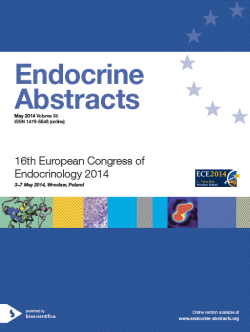Searchable abstracts of presentations at key conferences in endocrinology
Symposia
New hormones and endocrine tissues
ea0035s20.1 | New hormones and endocrine tissues | ECE2014
FGF21, irisin and other novel players in endocrine metabòlic regulation
Villarroya Francesc , Cereijo Ruben , Villarroya Joan , Giralt Marta
Brown adipose tissue (BAT) activity is a relevant component of energy expenditure in mammals. Moreover, BAT constitutes an active site of glucose and lipid draining and, therefore, BAT activity is also a relevant actor in the control of glycemia and lipidemia. Recent years, possibly because of the awareness that active BAT is present in adult humans, have witnessed a burst in the identification of novel endocrine factors released by peripheral tissues that can act on BAT beyon...
ea0035s20.2 | New hormones and endocrine tissues | ECE2014
Products of the ghrelin gene, their role in regulating β cell and adipocyte function
The ghrelin system comprises ghrelin, des-acyl ghrelin and obestatin, besides ghrelin receptor, GH secretagogue receptor type 1a (GHS-R1a), and the enzyme promoting ghrelin acylation, ghrelin-O acyl transferase (GOAT). The ghrelin peptides display different biological actions, including regulation of energy homeostasis and glucose metabolism, as well as survival and proliferative effects in different cell types. Besides the stomach, where they are mostly produced, ghr...
ea0035s20.3 | New hormones and endocrine tissues | ECE2014
The gut: a key organ coordinating the brain control of energy homeostasis
The extrinsic gastrointestinal nervous system plays a key role in the sensing of nutrients and hormones and its translation in terms of control of food intake by the CNS. Regarding major macronutrients as glucose and protein, they are sensed by the gastrointestinal neural system and the transmission of the signals to the brain promotes satiety phenomena. Glucose is sensed in the portal vein by neurons expressing the glucose receptor SGLT3 and activates the main regions of the ...




